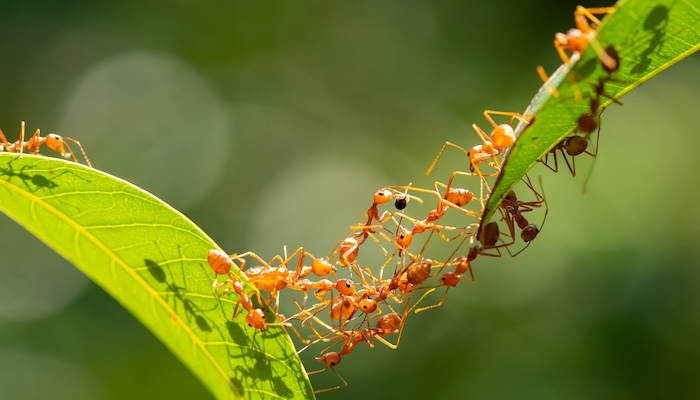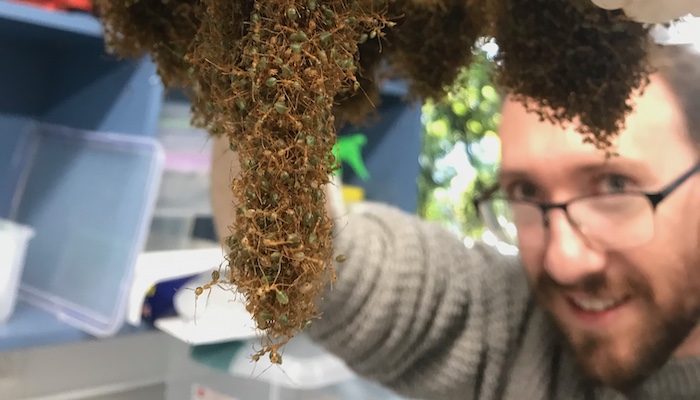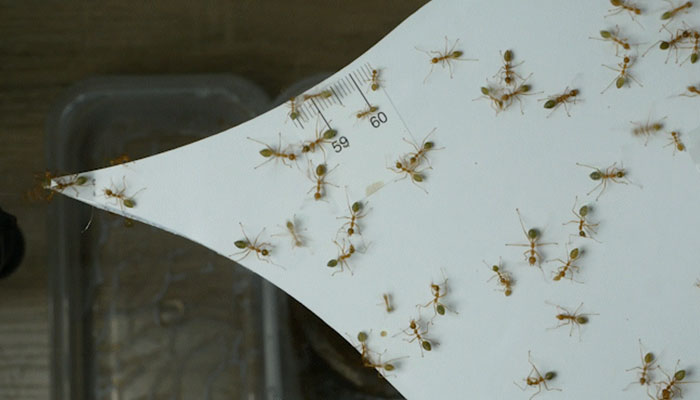Weaver ants have solved a problem that has plagued human teams for centuries: individuals contribute less to tasks when more people join in. New research just published in Current Biology shows individual weaver ants actually get stronger as their group grows.

Strong links: super-efficient weaver ant chains form to create aerial nests in the forest canopies of Africa, Asia and Australia.
The longstanding problem in human teams was first identified and published by French engineer Max Ringelmann in 1913 who measured students pulling on ropes. He found that while total force increased as more people joined in, each individual's contribution actually decreased.
Ringelmann's rule holds true in human teams ranging across everything from committees to sports teams. But Macquarie University behavioural ecologist Madelyne Stewardson, lead author of the new research, said weaver ants got better at collectively building their nests as the group size increased.
"Each individual ant almost doubled their pulling force as team size increased – they actually get better at working together as the group gets bigger," says Ms Stewardson.
Defying human limitations
The new study shows weaver ants form super-efficient teams in which individuals actually increase their contributions as teams grow bigger, defying the declining performance of individuals that affects human teams.
These tiny, tree-dwelling ants (Oecophylla smaragdina) found in tropical Africa, Asia and Australia, are known for their nest-building behaviours, forming a living chain to roll leaves and glue them with silk from their larvae, creating aerial nests in the forest canopy.
Stewardson and behavioural ecologist and supervising co-author Dr Chris Reid from Macquarie's School of Natural Sciences worked with an international team to measure and analyse the force different-sized ant teams could apply while building their nests.

Good behaviour: Macquarie University behavioural ecologist Dr Chris Reid analysed how weaver ant colonies worked together when building their nests.
The researchers set up experiments enticing weaver ant colonies to form pulling chains to move an artificial leaf connected to a force meter.
"The ants split their work into two jobs: some actively pull while others act like anchors to store that pulling force," says Stewardson.
How the ant team makes it work
Co-lead author Dr Daniele Carlesso from the University of Konstanz and Max Planck Institute of Animal Behavior in Germany, who was a PhD student at Macquarie during the research, says the team developed a theory called the 'force ratchet' to hypothesise how this works.
"The job each ant performs depends on its position in the chain." says Dr Carlesso. "Ants at the back of chains stretch out their bodies to resist and store the pulling force, while ants at the front keep actively pulling."
No one has looked into using a similar method as that used by the ants in order to generate force in swarms of multi-legged robots, but we plan to do this.
Dr David Labonte from Imperial College London, co-author on the paper, says the team found this method was key to increasing the contribution per individual as the team got bigger.
"Longer chains of ants have more grip on the ground than single ants, so they can better resist the force of the leaf pulling back," says Dr Labonte.
"The long chains effectively store the pulling force from individual ants in friction — together, the team seems to work like a ratchet."
Robot inspiration
Dr Reid says apart from delivering a fascinating insight into the natural world, the discovery could also help scientists design better robot teams.

Experiment: The new research has ignited hopes that super-efficient weaver ant behaviour can be replicated in robots.
When working in teams, current robots can only output the same force they do when alone — achieving at best a linear increase in force output. Weaver ants show there's potential for much more.
"No one has looked into using a similar method as that used by the ants in order to generate force in swarms of multi-legged robots, but we plan to do this," says Dr Reid.
Related work has already shown that robots with more legs on the ground, inspired by millipedes, can perform better on complex terrain.
"Programming robots to adopt ant-inspired cooperative strategies, like the force ratchet, could allow teams of autonomous robots to work together more efficiently, accomplishing more than the sum of their individual efforts," says Dr Reid.
Dr Chris Reid is a behavioural ecologist in the Macquarie University School of Natural Sciences.






